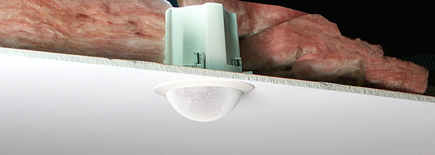|
|
|||||
|
|
|||||
|
|
|
||||
|
| |||||
|
Call Dave's Home Theater 1-800-715-4958
Audio is just as important as visual
requirement. So, you bought a $50,000 home
theater system but because of that, you are too broke to afford a decent
speaker system to match it. You'll soon realize that you have made a
mistake. But with such a wide range of speakers, from a
cheap $50 one to a $50,000 high end speakers, how do you decide which is
right for you? 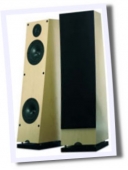 A
quality speaker cannot perform without quality data for it. The speaker
cables are the ones responsible for "transporting" these data to the
speakers, therefore be sure to get a quality cables too! This is
especially true for high end speakers. You can always try it out and
return the cables if it doesn't make a difference. A
quality speaker cannot perform without quality data for it. The speaker
cables are the ones responsible for "transporting" these data to the
speakers, therefore be sure to get a quality cables too! This is
especially true for high end speakers. You can always try it out and
return the cables if it doesn't make a difference.Plan where you are going to place your speakers and plan accordingly. You do not want to bring home you new sound systems only to realize that the cable are not long enough. Once you are sure that your cables are long enough, consider next whether you will need a speaker stand. A tower speaker do not usually need a speaker stand. A small and medium sized speakers, however may need one. Since mid-range and treble frequencies are very directional, it would be ideal if you ear is at the same level (height) the speakers are. If you have carpeted room, look for speaker stands that can be installed with spikes. Spikes can "tighten up" bass response by reducing sound-muddying vibrations thus providing greater quality. The Different Types Of Speakers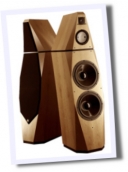 There
are several different types of speakers you can choose from. There are There
are several different types of speakers you can choose from. There are1. Floor standing speakers 2. Bookshelf speakers 3. Subwoofer or satellite systems 4. In-wall or in-ceiling speakers Floor standing speakers, commonly known as tower speakers are the most common and standard speakers. They are often three-way speakers, meaning they can reproduce high, medium and low frequencies. These are very powerful and very large in size but they also the most expensive and consume the most power. Bookshelf are ideal for those with limited space or budget. They are smaller in size which you can usually place on a shelf (thus the name) and still offers excellent performance. However, they are often only 2 way with no bass. Therefore many people who bought this model often purchase a separate powered subwoofer to give the system a deep bass. Satellite system are really really small. Some even small as your palm. Therefore it take very little space. You can easily place them anywhere convenient to you. That's their main advantage. However, their sound quality is directly related to their price. A satellite system that can reproduce a high quality sound is often much more expensive than it should. It also doesn't come with a bass unit. The bass is an omni-directional device, meaning it is hard to tell where the sound is coming from, therefore it can be placed anywhere out of your way but still fill the room. In-wall / in-ceiling speakers are normally used for commercial applications. The main advantage for this kind of speakers is that it saves space. Some higher end ones can produce a high quality playback while blending seamlessly into your room. However, just like any small-size speakers, they do not come with a bass. Grilles and brackets needed to blend the speakers with your wall are often sold separately and once installed, it is very difficult to move them. Therefore consider where you want to place it before purchasing. Lastly, the installation of an in-wall speaker is more difficult than the installation of a traditional speaker. You'll need to run the wire in the wall and so I would suggest that you get professionals to do it. How To Choose The Right Speakers?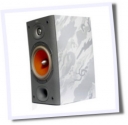 Again,
everyone has different preferences and therefore I would tell you which
brand and model to go for. Instead you should listen to them first
before investing. Again,
everyone has different preferences and therefore I would tell you which
brand and model to go for. Instead you should listen to them first
before investing.The first rule to follow when buying speakers is never to check out only "brand name" products. Some manufacturers of high-end speakers do not do much marketing and if you are not an enthusiast, you probably haven't heard of them, especially manufacturers of hand crafted speakers. Budget for everything that you are going to need before going shopping. From the speakers itself, the stand, the cables, the installation (if any) and the warranty. Maybe also the shipping. Your speakers is part of your furniture. Make sure that it also appeals to you visually and matches your room. When auditioning the speakers, bring some cds to test it. Do not bring engineered cds. Instead, bring a male and female vocals, bass or drums and instrumentals. You would want all these to sound clear and crisp. Always make sure you test-run the speakers before you buy it. The listening is very important. Choose to test in a quiet room with little disturbance. Estimate the size of the room to the room you want to place the speakers in. If the listening room is much smaller, it might appear to have less bass in a bigger room. Pop in your cds and play them. Do not request to play it in the highest volume possible like some morons do. Some speaker sounds fine at large volume but sounds compressed at lower volume. Instead, listen to the cds at the volume like you normally would. Last but not least, trust yourself. You are the one who is going to listen to it, not the salesman. Don't ask them to make the decision for you. If you like it, then get it.
In-wall and in-ceiling speakers have become some of our best-selling models, and it's easy to see why. They finally sound good enough to satisfy those who care about audio quality, and are also a great solution for folks who don't want to give up their floor or shelf space to traditional speakers. Below, we'll take a look at the things you should consider when buying in-wall or in-ceiling speakers. How they work: the basicsAn in-wall speaker works like a regular speaker. But instead of being attached to a cabinet, it's mounted in a frame and set into your wall. It uses the wall cavity as a large cabinet, giving you more bass than you might get from a stand-alone speaker of the same size. An in-ceiling speaker works essentially the same way, except that — you guessed it — it's installed in your ceiling. For the most part, in-wall speakers tend to be rectangular, and in-ceiling speakers tend to be round — but there's no reason you couldn't install a rectangular in-wall speaker in your ceiling, for example, if that's what you preferred. Almost all in-wall and in-ceiling speakers have paintable grilles, so you can camouflage them in your walls or ceiling.
Using in-wall and in-ceiling speakersTwo of the most important things to think about when shopping for in-wall or in-ceiling speakers are how you're going to use them and where you'd like to install them. For example, you'd probably buy a different type and number of speakers for surround sound in your home theater than you would for background music in the kitchen. Before you start looking at specific speaker models and features, you'll need to decide how and where you'll use them. You can find detailed recommendations for a number of different rooms and setups in our in-wall and in-ceiling speaker placement article. |
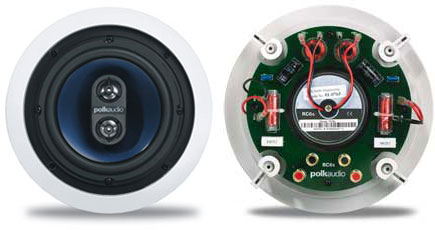 A single stereo-input speaker plays both the left
and right channels of stereo music through one woofer and two angled
tweeters.
A single stereo-input speaker plays both the left
and right channels of stereo music through one woofer and two angled
tweeters. |
What about a subwoofer?
If you're using in-wall or in-ceiling speakers for dedicated music listening or for home theater, a powered subwoofer is a must. It fills out the low frequencies, giving you warmer, more realistic sound. Many subwoofers are small enough to tuck behind a couch or table. We also offer subs that install in your wall, floor or ceiling for an elegant, space-saving solution.
5.1 Setup
This system has six channels: five full-range channels, and a low-frequency
effects channel (the .1 of 5.1) usually expressed through a subwoofer. Many DVDs
and digital broadcasts feature a Dolby® Digital (5.1) soundtrack, so
this will give you optimum sound for most programming. It also most closely
approximates the sound in most cinemas.
6.1 or 7.1 Setup
If possible, center your seating area between the surround speakers.
The closer you place a speaker to intersecting room surfaces (corners, wall and ceiling, wall and floor), the stronger the bass output. This can help bass-shy speakers, but it can also add too much bass. Again, just moving a speaker a few inches can often make a big difference in sound.
Call Us or let us Call You for any
questions you may have or to schedule an on site consultation at your place
Click to Call for us to call You Now
![]() Get A FREE Instant Quote
Get A FREE Instant Quote
Schedule Your Custom Electronics Installation. Call (800)
715-4958
Email Us at
daveshometheater@gmail.com
|
City's
We Service include Aliso Viejo 92656, Aliso Viejo 92698, Anaheim 92801, Anaheim 92802, Anaheim 92803, Anaheim 92804, Anaheim 92805, Anaheim 92806, Anaheim 92807, Anaheim 92808, Anaheim 92809, Anaheim 92812, Anaheim 92814, Anaheim 92815, Anaheim 92816, Anaheim 92817, Anaheim 92825, Anaheim 92850, Anaheim 92899, Atwood 92811, Brea 92821, Brea 92822, Brea 92823, Buena Park 90620, Buena Park 90621, Buena Park 90622, Buena Park 90624, Capistrano Beach 92624, Corona del Mar 92625, Costa Mesa 92626, Costa Mesa 92627, Costa Mesa 92628, Cypress 90630, Dana Point 92629, East Irvine 92650, El Toro 92609, Foothill Ranch 92610, Fountain Valley 92708, Fountain Valley 92728, Fullerton 92831, Fullerton 92832, Fullerton 92833, Fullerton 92834, Fullerton 92835, Fullerton 92836, Fullerton 92837, Fullerton 92838, Garden Grove 92840, Garden Grove 92841, Garden Grove 92842, Garden Grove 92843, Garden Grove 92844, Garden Grove 92845, Garden Grove 92846, Huntington Beach 92605, Huntington Beach 92615, Huntington Beach 92646, Huntington Beach 92647, Huntington Beach 92648, Huntington Beach 92649, Irvine 92602, Irvine 92603, Irvine 92604, Irvine 92606, Irvine 92612, Irvine 92614, Irvine 92616, Irvine 92617, Irvine 92618, Irvine 92619, Irvine 92620, Irvine 92623, Irvine 92697, La Habra 90631, La Habra 90632, La Habra 90633, La Palma 90623, Ladera Ranch 92694, Laguna Beach 92651, Laguna Beach 92652, Laguna Hills 92653, Laguna Hills 92654, Laguna Niguel 92607, Laguna Niguel 92677, Laguna Woods 92637, Lake Forest 92630, Los Alamitos 90720, Los Alamitos 90721, Midway City 92655, Mission Viejo 92690, Mission Viejo 92691, Mission Viejo 92692, Newport Beach 92658, Newport Beach 92659, Newport Beach 92660, Newport Beach 92661, Newport Beach 92662, Newport Beach 92663, Newport Coast 92657, Orange 92856, Orange 92857, Orange 92859, Orange 92862, Orange 92863, Orange 92864, Orange 92865, Orange 92866, Orange 92867, Orange 92868, Orange 92869, Placentia 92870, Placentia 92871, Rancho Santa Margarita 92688, San Clemente 92672, San Clemente 92673, San Clemente 92674, San Juan Capistrano 92675, San Juan Capistrano 92693, Santa Ana 92701, Santa Ana 92702, Santa Ana 92703,Santa Ana 92704, Santa Ana 92705, Santa Ana 92706, Santa Ana 92707, Santa Ana 92711, Santa Ana 92712, Santa Ana 92725, Santa Ana 92735, Santa Ana 92799, Seal Beach 90740, Silverado 92676, Stanton 90680, Sunset Beach 90742, Surfside 90743, Trabuco Canyon 92678, Trabuco Canyon 92679, Tustin 92780, Tustin 92781, Tustin 92782, Villa Park 92861, Westminster 92683, Westminster 92684, Westminster 92685, Yorba Linda 92885, 92886, 92887Seal Beach, Diamond Bar, Sunset Beach, Riverside, Corona, Alta Loma, Rancho Cucamonga, Upland, Claremont, Ontario, Chino, Chino Hills, Paris, Murrieta, Beverly Hills, Brentwood, Santa Monica, Cypress, Rolling Hills, Long Beach, San Fernando Valley, Burbank, Hollywood, Palos Verdes, Fullerton, Ventura, West Hills, Marina Del Ray, Malibu, North Ridge, Box Canyon, Del Mar, Vista, South Bay, Santa Monica, San Fernando Valley, West Hills, Woodland Hills, Box Canyon, Manhattan Beach, Rolling Hights, Simi Valley, SFV OC LA IE SD |


Licensed & Insured , License # 909750
Site Map Speakers Prices Info Cable



